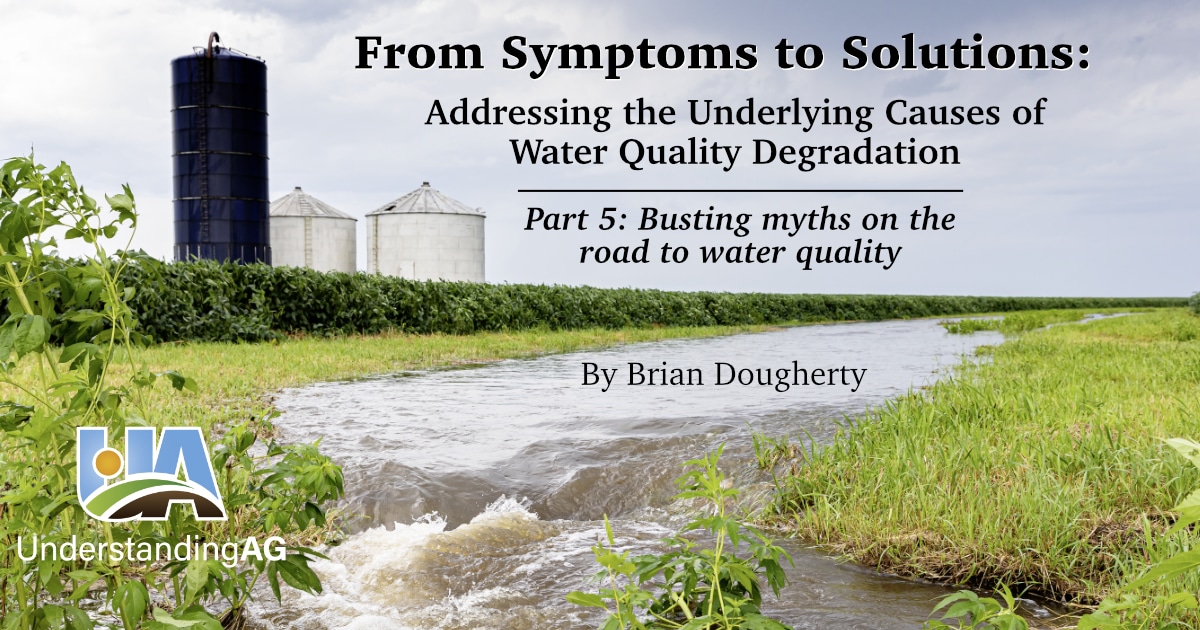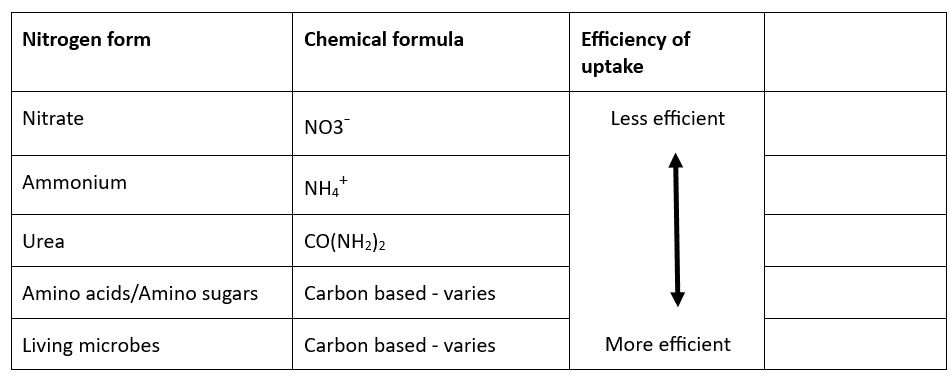
In Part Four, I discussed the importance of keeping living roots in the soil and avoiding overapplication of nutrients at the wrong time. In this final post I will examine nitrogen sourcing options and how plants acquire nutrients in a healthy soil.
To understand what the ‘right source’ of nitrogen is, we first need to review the different forms that are taken up by crops (Table 4). Nitrate and ammonium are inorganic forms of nitrogen, meaning they are not attached to a carbon atom. Think of nitrate as the problem child of nitrogen forms. It is readily taken up by plants, but it is highly soluble in water and carries a negative charge, so it does not stick to clay particles. This makes it highly prone to leaching. Wherever water goes, nitrate goes. Ammonium also dissolves in water, but it carries a positive charge. It will stick to clay particles and generally does not leach.
Table 4. Forms of nitrogen available for plant uptake.
Nitrate is also the least efficient form of N from a plant’s perspective. To understand why, we need to understand what a plant does with nitrogen. Plants need to make amino acids, which are nitrogen-containing molecules that combine to form proteins. Each molecule of nitrate requires three molecules of water to make an amino acid. Using nitrate to make amino acids makes the plant less water efficient. The process also takes a significant amount of photosynthetic energy, which is then not available for other important physiological processes.
Busting the ‘leaky’ soil myth
It’s said that our cropping systems in the Midwest are ‘leaky’ and that nitrate leaching is unavoidable. This is false. The problem is not our soil, it’s how we manage it. Properly functioning soil does not lose nutrients, it recycles them. In healthy soil, biological activity makes small amounts of nitrate available to the plant as needed, which is quickly used and recycled before it leaches away. Farming in a way that relies on organic nitrogen and biological activity rather than overloading the soil with nitrate will minimize leaching. To put it simply, nitrate cannot leach if it’s not there. Tile drainage complicates efforts to minimize leaching, but this can be mitigated with the 6Ps and a biological approach to nutrient management.
Many common fertilizers are either already in the nitrate or ammonium form, or quickly convert to those forms in the soil. To improve nitrogen-use efficiency (NUE) and reduce leaching, we can apply amino acid-based forms of nitrogen like fish hydrolysate, algae, and seaweed-based products instead. These are organic forms of nitrogen, meaning they contain carbon. These are very efficient when applied in furrow or as a foliar spray. Amino nitrogen forms provide energy to the plant, rather than using energy as is the case with nitrate. These forms of nitrogen also do not inhibit soil biology. Another efficiency hack is to dissolve urea and apply it as a foliar. This is approximately 10 times more efficient than applying it to the soil. Plants can take up amino forms of nitrogen directly and skip the water and energy-intensive assembly step of using nitrate. As a bonus, carbon-based forms of nitrogen do not leach or volatilize, and they do not contribute to water quality problems, but rather stay in the soil and cycle through the soil food web. It’s critical to keep in mind that it’s not just a matter of applying organic forms of N. We need biological activity and good soil aggregation for organic nitrogen to be used by the plant.
Nitrogen should always be applied in combination with a source of carbon. This is another very simple way to reduce nitrate leaching and the amount of N applied. Humic-based products can help convert readily available forms of N back to organic N that does not leach or volatilize. Nitrification inhibitors like DCD and DMPP are designed to inhibit or kill nitrifying organisms. These products are band-aids, not solutions. Humates are natural nutrient stabilizers that enhance soil and plant health. They are the closest thing we have to a no-brainer when it comes to nutrient management and should be part of all crop fertility, manure management, and herbicide programs.
Busting the plant nutrient acquisition myth
You may have noticed something very strange in Table 4. It says living microbes. This may sound crazy, but it’s true. Plants attract and ingest living microbes through the root tip and strip off their cell wall for nutrition. This process is called the rhizophagy cycle. The incredible work Dr. James White and others have done in recent years to understand this process has completely revolutionized everything we thought we knew about how plants access nutrients.
The old model of nutrient acquisition assumes that plants access nutrients by taking them up from soil solution. This is true in dysfunctional soil - it’s basically a hydroponic system. But this is a very incomplete way of understanding nutrient cycling and it leads to poor fertility management decisions that degrade soil and water quality and are disconnected from how healthy soil actually functions. The ‘right source’ of fertility is not fertilizer at all – it is soil organisms. Soil biology should feed nutrients to your plants, and your plants should feed carbon to soil biology in return. This relatively simple change, accomplished by integrating the 6Ps and refocusing our management to nurture life in the soil, would radically transform agriculture for the better and deal with the root cause of dysfunctional soil and poor water quality.
The old model of plant nutrient acquisition is dead, and we need to stop teaching it and bury it. We cannot use simple formulas to determine nutrient application rates. Farming in a way that ignores or actively inhibits biological nutrient cycling is the primary cause of soil and water quality degradation. We need our land grant universities to step up and lead the way on this. Rather than focusing on outdated fertility concepts and farming practices that degrade soil, education and research should begin and end with the fundamental premises that soil, plant, animal, and human health are inseparable and biological farming systems are the only sustainable way to feed the world. When we harm biology in the soil, we harm everything, and we eat, drink, and live with the polluted results, and increasingly suffer from the consequences.
The road to improved water quality, farm profits
In wrapping up this series, I want to leave you with eight practical and effective steps that I believe can address the underlying causes of water quality degradation in agriculture.
For farmers and landowners:
- Implement the six principles of soil health with priority given to maintaining continuous living roots.
- Throw out your old nutrient and pest management playbooks and learn how to manage soil and plants as an integrated biological system that nurtures life in the soil.
- Apply organic forms of nitrogen in small doses near the time of plant uptake.
- Use biology-friendly fertilizers and stabilize nutrients and manures with humates.
- Focus on growing healthy, pest-and disease-resistant plants that are connected to their soil microbiome.
For industry, government, academia, and consumers:
- Require annual soil stewardship training for all landowners, renters, and agribusiness personnel focusing on the 6Ps, ecosystem processes, biological nutrient management, and how to grow healthy, pest and disease resistant plants.
- Discontinue spending on engineering fixes and programs that distort markets and encourage overproduction of commodities. Divert those resources to 6P education and implementation.
- Couple industry, government, and academic resources with consumer purchasing power to support a system-wide transition to regenerative land management and refuse to support companies, organizations, or politicians standing in the way.
The only way to address agricultural water quality problems at scale is with a biological approach to land management. We know how to do it, and we owe it to ourselves and future generations to act now. It's time for the agricultural community to come together and show that we really are the best stewards of the land. It’s not just the right thing to do, it’s also the smart thing to do.
The sooner we focus on implementing the 6P strategy to make our soils healthier and better functioning, the sooner we can improve our water, our profits, our health, and our future.
